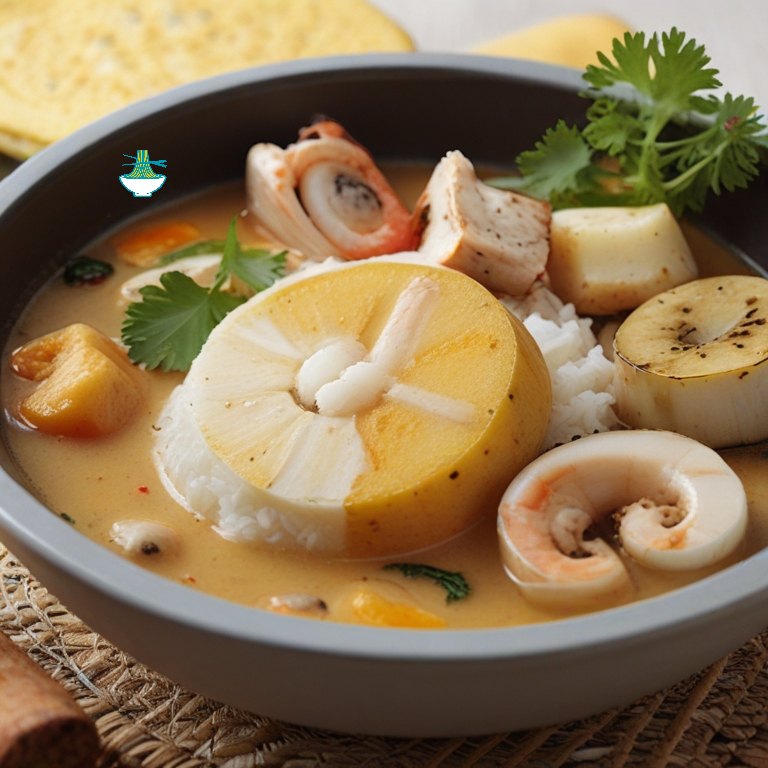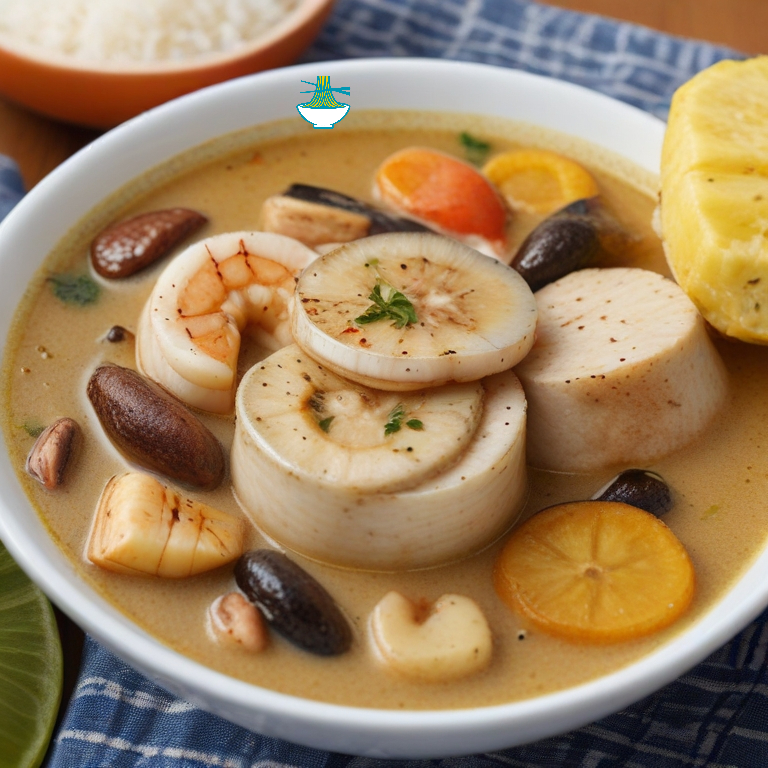Immerse yourself in the vibrant flavors of Guatemala with the exquisite dish known as Tapado. Hailing from the coastal regions of this Central American paradise, Tapado is a rich and aromatic seafood stew that captures the essence of Guatemala's culinary heritage.
Comprising a tantalizing blend of fresh seafood such as shrimp, fish, and shellfish, simmered in a fragrant coconut broth infused with spices and tropical herbs, Tapado offers a symphony of flavors that delight the palate and evoke the warmth of Guatemala's coastal breeze. Served with a side of rice or plantains, this traditional delicacy is a testament to the country's bountiful seafood harvest and cultural diversity. Experience the essence of Guatemala's coastal cuisine with every spoonful of Tapado, a culinary treasure that invites you on a journey to the heart of this captivating land.
Ingredients:
- 1 lb mixed seafood (shrimp, fish fillets, mussels, clams, squid), cleaned and deveined
- 2 ripe plantains, sliced
- 1 medium yuca (cassava), peeled and diced
- 1 can (14 oz) coconut milk
- 1 onion, finely chopped
- 3 cloves garlic, minced
- 1 red bell pepper, diced
- 1 green bell pepper, diced
- 1 tomato, diced
- 2 tablespoons vegetable oil
- 2 cups fish or seafood broth
- 1 teaspoon ground cumin
- 1 teaspoon paprika
- Salt and pepper to taste
- Fresh cilantro, chopped (for garnish)
- Lime wedges (for serving)
- Cooked rice (optional, for serving)

Instructions:
1- In a large pot or Dutch oven, heat the vegetable oil over medium heat. Add the chopped onion and garlic, and sauté until softened and fragrant, about 2-3 minutes.
2- Add the diced bell peppers and tomato to the pot, and cook for another 3-4 minutes until the vegetables are tender.
3- Pour in the coconut milk and fish or seafood broth, and stir well to combine. Bring the mixture to a simmer.
4- Add the sliced plantains and diced yuca to the pot, and let them cook in the simmering broth for about 10-15 minutes until they start to soften.
5- Season the broth with ground cumin, paprika, salt, and pepper according to your taste preferences.
6- Once the plantains and yuca are partially cooked, add the mixed seafood to the pot. Let the seafood cook in the broth for about 5-7 minutes until they are fully cooked through and tender.
7- Adjust the seasoning if necessary, adding more salt and pepper as needed.
8- Serve the Guatemala Tapado hot, garnished with freshly chopped cilantro and accompanied by lime wedges for squeezing over the stew. Optionally, serve with cooked rice on the side to soak up the flavorful broth.
9- Enjoy this delicious seafood stew that captures the essence of Guatemala's coastal cuisine!
Nutritional Values :
Mixed seafood (shrimp, fish fillets, mussels, clams, squid):
- Calories: 150-200 kcal per 100g
- Protein: 15-20g per 100g
- Fat: 2-10g per 100g
- Carbohydrates: 0g per 100g
benefits
- Rich source of protein, essential for muscle growth and repair.
- Provides omega-3 fatty acids, which are beneficial for heart health and brain function.
Plantains:
- Calories: 120 kcal per 100g
- Protein: 1g per 100g
- Fat: 0.3g per 100g
- Carbohydrates: 31g per 100g
- Fiber: 2.3g per 100g
benefits
- High in complex carbohydrates, providing sustained energy.
- Good source of dietary fiber, aiding digestion and promoting a feeling of fullness.
Yuca (cassava):
- Calories: 160 kcal per 100g
- Protein: 1.4g per 100g
- Fat: 0.3g per 100g
- Carbohydrates: 38g per 100g
- Fiber: 1.8g per 100g
benefits
- Contains resistant starch, which acts as a prebiotic and supports gut health.
- Provides vitamin C, important for immune function and collagen synthesis.
Coconut milk (canned, unsweetened):
- Calories: 150 kcal per 100ml
- Protein: 1.5g per 100ml
- Fat: 15g per 100ml
- Carbohydrates: 2g per 100ml
- Fiber: 0g per 100ml
benefits
- Contains medium-chain triglycerides (MCTs), which may boost metabolism and provide quick energy.
- Rich in lauric acid, with potential antimicrobial and anti-inflammatory properties
Onion:
- Calories: 40 kcal per 100g
- Protein: 1.1g per 100g
- Fat: 0.1g per 100g
- Carbohydrates: 9.3g per 100g
- Fiber: 1.7g per 100g
benefits
- Rich in antioxidants such as quercetin, which may have anti-inflammatory and anticancer effects.
- Contains sulfur compounds that may support detoxification and cardiovascular health.
Garlic:
- Calories: 149 kcal per 100g
- Protein: 6.36g per 100g
- Fat: 0.5g per 100g
- Carbohydrates: 33.06g per 100g
- Fiber: 2.1g per 100g
benefits
- Has antimicrobial properties that may help fight infections and support immune function.
- Contains allicin, which may help lower blood pressure and cholesterol levels.
Bell peppers (red and green):
- Calories: 31 kcal per 100g (red), 20 kcal per 100g (green)
- Protein: 1g per 100g
- Fat: 0.2g per 100g
- Carbohydrates: 6g per 100g
- Fiber: 2.1g per 100g
benefits
- Excellent source of vitamin C, which is crucial for immune function and skin health.
- Rich in antioxidants like beta-carotene, which may protect against chronic diseases.
Tomato:
- Calories: 18 kcal per 100g
- Protein: 0.9g per 100g
- Fat: 0.2g per 100g
- Carbohydrates: 3.9g per 100g
- Fiber: 1.2g per 100g
benefits
- High in lycopene, a powerful antioxidant that may reduce the risk of certain cancers and promote heart health.
- Contains vitamin K and potassium, important for bone health and blood pressure regulation.
These values are approximate and can vary based on factors such as specific varieties of ingredients and cooking methods. It's always a good idea to refer to specific product labels or use a nutritional calculator for precise values.


Comments